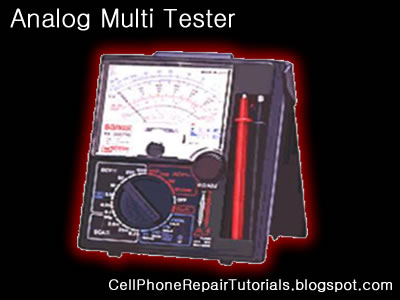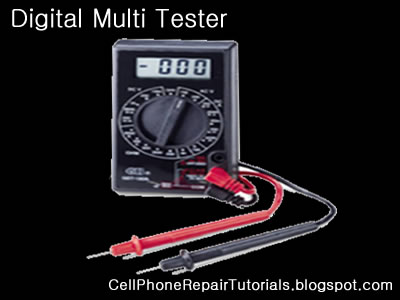What is a multimeter tester?
A multitester or multimeter is a device which can be used to gather data about electronics circuits. A basic multitester can measure resistance, voltage,current and continuity, while more advanced versions may be able to provide additional data.
Multitesters can be used with the current off or on in most cases, although using the device with the current on can sometimes result in damage to the device.This device is hand held, and powered by batteries. It consists of two probes attached to a central pack which can be digital or analog. The device has a series of buttons or switches which can be used to set the type of measurement being performed.
Analog Multitester
Analog types are been able to read manually to its Reading the needle pointing to a gauge, it requires a some computation when checking some components or where the selector is being set.
Basic Multitester has features like as follows:
Resistance Set Value: x1,
x10, = multiply by 10
x1K= it means multiply it by 1000
x10K = it means multiply it by 10,000
DC Set Value: from 0.1 to 1000 DC Voltage (Direct Current)
AC Set Value: from 10 to 1000 AC Voltage (Alternating Current)
DC Current Set Value: from 0.5micro ampere to 50 micro ampere
Continuity, the most basic measurement provided by a multitester, determines whether or not a circuit is complete. For a continuity test, the device is set to “ohms” and AC or DC, depending on the current being measured, before the probes on the device are inserted into the circuit. If the circuit is complete, the readout will measure between 0 and .05 ohms. A measurement of infinity indicates that the circuit is open, which means there is a problem.In addition to being used as a basic continuity tester,
Digital Multitester
A digital multimeter is a tool that can measure amps, volts, and ohms. It is different from an analog meter, which has a needle and a gauge, in that it has a digital light-emitting diode (LED) display. Digital multimeters are typically more accurate than their old analog counterparts. A digital multimeter can also have other functions; obviously, the more expensive meters will have more features, but all of them measure the three basic currents.
Another specification to consider when purchasing a DMM is its range. Regardless of what current is being tested, the proper range for that measurement is critical to the accuracy of the measurement. If the operator were testing a 12-volt battery, for instance, then a range setting of 0 to 25 volts would result in a more accurate measurement then a range setting of 0 to 500 volts. Thankfully, many DMM’s have an automatic range feature, which will set the proper range for the circuit being tested automatically; all the operator has to do is set the DMM to the proper current being tested, and the meter does the rest.
When using a DMM for the first time, it is essential that a person read the instruction manual that comes with it. Many DMM’s require different steps for taking measurements; this will entail pressing certain buttons before hooking up the leads, and so on. Most digital multimeters require a battery for operation. The instruction manual will most likely specify which type of battery to use. If the battery type is not specified, alkaline batteries are typically used.
A DMM’s maximum reading capacity is extremely important as well. This is the maximum amount of current that the meter can measure. Usually, the current limit is printed on the face of the DMM. A common limit is 10 amps. This means that if the meter is hooked up to a current of 12 amps, the internal fuse will pop to prevent damaging the meter. Installing a bigger fuse will not increase the limit of the DMM; it will only burn it out permanently.

Custom Search
Blog Archive
Popular Posts
-
Almost all equipments with LCD displays utilize flat flexible cable to connect the display to the main circuit board.These flat cable ribbon...
-
Using a multimeter is quite bit difficult for the first time especially the analog type one unlike the digital which is more convenient to u...
-
A SIM Card also known as Subscriber Identity Module , A SIM is a Smart Card that can store data from a cellular phone. Those data like id...
-
This is where you can learn a step by step from basic to advance procedure on how to fix major mobile phone handsets problems such as Nokia,...
-
Odin Flasher Tool for all Samsung Android firmware. The Odin flasher software has been used to manually install Samsung original stock firmw...
Labels
- Advance Turbo Flasher Guide
- Android OS / Windows Mobile Hard Reset Guides
- Android Software Tools
- Apple iPad 2
- Apple iphone
- apple iphone 4
- Apple iPhone Firmwares
- Application Support
- AxeBox Guides
- Blackberry FAQ
- BlackBerry Hardware Repair Guides
- Blackberry MEP Reader
- Blackberry Torch 9800
- Cell Phone Repair Tips
- China Phone Hardware Solution
- China Phone Chips
- China Phone Pinouts
- China Phone Schematic Diagram
- China Phone Tools
- China Phones Flashfiles
- CPF-BOX II Guides
- Cruiser Team Product Guides
- Cyclone Box Guides
- Digi Mic Knopfler
- Disassembling Manuals and Video Guides
- Free Unlocker Software Tools
- Furious Gold Guides
- Google Nexus S
- HTC Hard Reset
- HTC Service Manual
- HTC Software Tools
- Htc Unlock
- Infinity Box Guides
- iPhone Jailbreaking
- iPhone Software Solution
- iPhone Software Tools
- iPod Touch Firmwares
- jaf box repair
- Japanese Phones
- Kyocera Hard Reset
- LG Hard Reset
- LG Firmwares
- LG Schematic Diagram
- LG Software Tools
- Memory card format sofware
- Mobile Phone Codes
- Mobile Phone Repair basics
- MOBILedit
- Motorola Firmwares
- Motorola Hard Reset
- MXKEY Guides
- Nokia Hardware Repair Solutions in EXE
- Nokia IC Datasheet
- Nokia Software
- Nokia 5310 Xpressmusic Repair Guides
- Nokia 5730 Xpressmusic Repair Guides
- Nokia 5800 Xpressmusic Repair Guides
- Nokia BB5 Flashfiles
- Nokia Connectivity Cables
- Nokia DCT3 DCT4 WD2 Flashfiles
- Nokia Flashfiles
- Nokia Hard Reset
- Nokia Hardware Solutions
- Nokia N900 Repair
- Nokia Pinouts
- NOKIA PM /Rpl Files
- Nokia Schematic Diagram
- Nokia Smartphones Hard Reset
- Nokia Software Tools
- Nokia Solutions in shell
- Nokia Spare Parts Compatible
- Nokia X2 Repair Guide
- Odin Flasher
- Online Spare Parts Store
- Sagem Software Tools
- Samsung Flashfiles
- Samsung Hard Reset
- Samsung Service Manual
- Samsung Smartphone OS
- Samsung Tool
- SE USB Driver
- Security Phone Code Reset
- Sharp Schematic Diagram
- Siemens Schematic Diagram
- Smart Phone Software Tools
- Smartphone ROM Firmware
- Software Support
- Sony Ericsson Experia Neo
- Sony Ericsson experia X1
- Sony Ericsson Experia X10
- Sony Ericsson Experia X10 mini
- Sony Ericsson experia X8
- Sony Ericsson Flashfiles
- Sony Ericsson Hard Reset
- Sony Ericsson PlayStation phone
- Sony Ericsson Shematic Diagram
- SonyEricsson FAQ
- Spiderman Box Guides
- Sprint 7700 hardware repair
- Vygis Toolbox Guides
- Z3X Guides
Copyright © 2011 - 2012 Free CellPhone Repair Tutorials | Powered by Blogger






0 comments:
Post a Comment